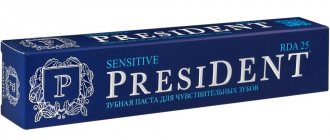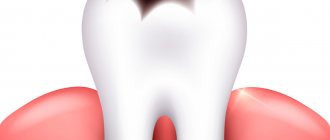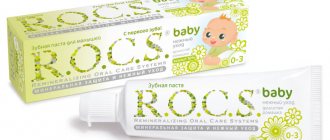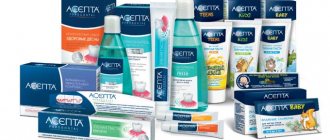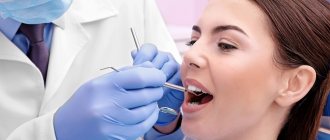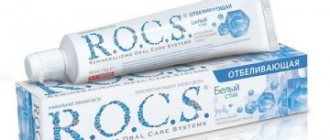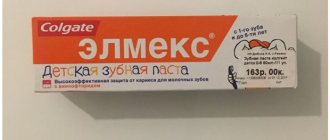At an appointment with a pediatric dentist, parents most often ask questions about how to prevent dental disease and what to do to maintain their health. We all know that caries occurs as a result of the activity of harmful microorganisms in the oral cavity. These microorganisms feed on pieces of food stuck in the teeth, wash out beneficial minerals from the tooth and lead to its destruction, sometimes tartar.
Remember that the health and beauty of permanent teeth directly depends on the health of baby teeth. You should not hope that if there is a problem with a baby tooth, it will fall out later and there is no need to treat it. Parents should prevent any diseases by taking preventive measures in time.
Of course, everyone wants their child to use the best, safest and most effective products. Let's talk about one of the very good ingredients for baby's dental care products - xylitol.
Where is xylitol used?
It tastes like regular sugar and does not have the unpleasant aftertaste that other artificial substitutes have. Xylitol, as a low-calorie substance with a low glycemic index (GI), was used in European countries back in the 19th century as a treatment for patients with diabetes.
In the modern world, manufacturers in many countries add xylitol to food and medicines. Sweets, chewing gum, candies, syrups, toothpastes, lollipops and chewable multivitamins are not complete without the addition of birch sugar.
Xylitol is a real salvation for those dieters who find it difficult to completely give up sweets. It is quite capable of replacing the usual sugar. Xylitol has a low calorie content and can be added to cold and hot drinks and snacks.
Filimonov Oleg Vladimirovich
Implant surgeon, orthopedist
I rather lean not towards substitutes, but towards sugar “cancellers”. We eat too many carbohydrates, so it makes sense to cut them down. But part of the remainder can be replaced.
Pastes with whitening effect
Many manufacturers of whitening toothpastes are disingenuous when they call them whitening; it would be more correct to call them “brightening” or “with an increased cleansing effect.” Lightening of enamel in pastes occurs by removing plaque and returning the natural color to the teeth. True enamel whitening can only be done in the dentist's office.
Removal of plaque using this group of products occurs due to increased abrasiveness; a tube of paste with a truly cleansing effect should contain information about the abrasiveness index. It is designated by the letters RDA; the higher the digital value of the index, the larger the grinding particles. RDA index values:
- 30-50 – non-abrasive paste, suitable for cleaning sensitive teeth;
- 50-80 – low abrasive, can be used by children over 14 years of age;
- 80-100 – moderately abrasive, used by adults daily;
- 100-200 – high abrasiveness of the paste, teeth are brushed 1-2 times a week, sometimes less often; It is advisable to consult a dentist before use.
The recommended abrasiveness for daily use is RDA 70-80, but you need to focus on the condition of your teeth and gums.
There are pastes in which the enamel is cleansed not through abrasive particles, but through the action of the enzymes papain and bromelain. Enzymes enter into a chemical reaction with plaque, gradually dissolving it.
If the packaging of a whitening toothpaste does not contain information about the RDA index or does not contain enzymes, it is unlikely that this product will be able to lighten tooth enamel.
Xylitol and dental health
It is birch sugar that can protect our teeth from the harmful effects of acids that cause the process of demineralization. Chalky spots, especially noticeable on the incisors of baby teeth, are the initial stage of caries, which is still reversible. It is important to notice it in time and stop it before more serious treatment is required.
Saliva, which has an alkaline pH, helps partly in this process. By washing your teeth, it neutralizes acid and saturates the enamel with beneficial fluoride and calcium. But the problem is that those with a sweet tooth typically have a carbohydrate diet, so saliva can lose its beneficial properties, acquiring the same acidic composition as table sugar. Thus, the bacteria receive an additional source of nutrition, starting the same demineralization process.
The peculiarity of xylitol for teeth is that it does not support the normal life processes of dangerous bacteria and thereby provokes their death. As a result, the acid-base balance is normalized and the adverse effects of acids on tooth enamel are reduced.
What types of toothpastes are there?
Based on their effect on the oral cavity, pastes are divided into therapeutic, therapeutic and prophylactic and prophylactic. Belonging to one or another group is indicated on the front side of the package, so determining the purpose of the paste at the time of purchase is not difficult.
Depending on the age orientation, pastes are divided into children's and adults. Children's products for small children have a special composition, since there are often cases of them being swallowed by children during cleaning, and the components of adult pastes are prohibited here. Manufacturers add the same substances to toothpastes for older children as to adult products, but in lower concentrations.
Benefits of xylitol for teeth and oral health:
- reduction in the development of carious processes;
- strengthening enamel;
- increased saliva production with increased protective properties;
- stabilization and neutralization of the initial stage of caries;
- control of infection of the oral cavity by the fungus Candida albicans.
It is noteworthy that the beneficial effects of xylitol persist long after treatment or preventive measures. And its indisputable advantage is that it is absolutely harmless when the permissible dosage is observed. If the consumption limit is exceeded, a laxative effect may be observed, as is the case with any sugar alcohols. This is the only harm of xylitol.
Filimonov Oleg Vladimirovich
Implant surgeon, orthopedist
Xylitol is neither beneficial nor harmful. It has no biological value and does not cause the proliferation of microorganisms. But due to its sweet taste, xylitol stimulates the production of saliva, which helps cleanse the mouth by better washing the teeth. Therefore, xylitol helps prevent caries. However, it should be understood that only a sugar substitute is not able to prevent caries, since its prevention is a set of measures, and not just chewing gum.
A new way to solve the problem of early dental caries
The wide prevalence caries in young children determines the relevance of searching for ways to prevent this disease. caries is a long-term chronic process, which is the focus and source of infection and allergization of the child’s body, since with food the child constantly swallows a large number of microorganisms, as well as decomposition products of tooth tissue and food that linger in the carious cavity. In addition, these same microorganisms, their toxins and waste products are absorbed into the blood through the mucous membrane of the mouth and at the points of contact between the tooth and the jaw. Constant infection of the body and its sensitization contribute to the development in children of chronic tonsillitis, rheumatism, kidney diseases, joints, gastrointestinal tract and weakened vision.
The first signs of dental caries may appear in children during the eruption of baby teeth. The number of carious teeth in one child, as well as the number of carious cavities in one tooth, varies and determines the degree of caries . With a compensated course of caries, a 10-12 year old child in the oral cavity has no more than 4 teeth affected by caries , with subcompensated - up to 8-9 teeth. The decompensated form of caries is characterized not only by a large number of affected teeth (more than half of the total number), but also by a large number of carious cavities. There may be a large number of decayed teeth devoid of pulp. When treating such teeth, it is difficult to achieve good fixation of fillings; the teeth do not withstand optimal physical stress and are quickly destroyed. Therefore, it is very important to prevent caries to the stage of decompensated form. Of particular importance is the prevention of caries , starting from an early age.
Development of caries
To date, sufficiently convincing evidence has been obtained for the role of microorganisms in the occurrence of caries . For the occurrence and development of caries, the following conditions are necessary [1]:
- Presence of cariogenic microflora.
- Intake from food and retention of easily digestible carbohydrates on the surface of tooth enamel.
- Reduced resistance to the effects of cariogenic factors.
It is believed that the causative agent of caries is the bacteria Streptococcus mutans (Str. mutans). The theory of the microbial etiology caries has long been the subject of debate, but currently the role of microorganisms in the occurrence of caries can be considered proven. In particular, the relationship between the presence of Str. mutans in saliva, the formation of microbial plaque and the development caries .
Bacteria Str. mutans are transmitted from person to person, infection usually occurs at an early age, often Str. mutans are found in a child's mouth even before the first teeth erupt.
Two oppositely directed processes continuously occur in teeth - demineralization and restoration of mineralization (remineralization): due to the action of microorganisms, first on the tooth enamel, and then on the hard tissues of the tooth, mineral substances, for example, calcium, are washed out, i.e. the teeth are demineralized. Saliva has a neutralizing effect on this process: excess minerals in its composition are deposited back into the hard substance of the teeth - remineralization of the teeth occurs. A shift in balance towards demineralization leads to weakening of tooth enamel.
Caries infection begins with infection of the oral cavity by bacteria Str. mutans. A feature of these bacteria is their high adhesiveness to oral tissues, which allows them to form dental plaque - yellowish or grayish deposits on the surface of the teeth. Dental plaque is a type of biofilm. Bacteria Str. mutans, which have a high adhesive ability, due to coadhesion, create favorable conditions for attachment to the tissues of the oral cavity and other microorganisms that are not able to stay in the oral cavity on their own. Thus, various pathogenic microflora can be retained, including pathogens of otitis media, pneumonia, and stomach ulcers. Soft plaque does not adhere tightly to the cells of the oral cavity, so it is relatively easy to remove. If this is not done, dental plaque contributes to the formation of dental plaque - a pathological conglomerate consisting of microorganisms, the polysaccharides they produce, as well as food debris. Dental plaque is attached to the surface of the tooth quite tightly and is much more difficult to remove than plaque.
At the site of plaque formation - that is, in practically anaerobic conditions, isolated from the external environment - acidic metabolites secreted by bacteria, in particular lactic acid, begin to destroy tooth enamel. Str. mutans not only produce organic acids, but are also acid tolerant and are able to survive in acidic plaque conditions at a pH below 5.5. Under the influence of acids, a defect in the tooth tissue begins to form at the site of the dental plaque, and a carious cavity appears. The most common places for caries are natural depressions on human teeth, most often on the chewing surface, the space between the teeth, and the area of the tooth neck along the gingival edge.
Demineralized areas of the tooth surface appear as white spots. to recognize caries at this stage; white spots on the teeth can easily be confused with the manifestation of fluorosis. Caries on a child's first teeth develops slowly and the process can take months. Subsequently, as the infection progresses, these white spots may turn brown. Noticeable damage to the teeth means that the pathological process has gone very far. Subsequently, caries will spread much faster, and it will become much more difficult to fight it. Therefore, the best way to protect your child’s teeth from caries is to prevent damage. The most effective and feasible strategy to combat caries is the introduction of healthy oral hygiene habits and the promotion of dental care practices at home. Leftover food, which is a nutrient medium for Str. mutans must be removed regularly and on time. Parents and caregivers should provide regular oral hygiene to their children. In order for the procedure to take hold and become firmly established in the daily care routine, the oral hygiene product must be effective, safe, convenient and, most importantly, must be positively perceived by the child. Xylitol CH2OH(CHOH)3CH2OH, a safe natural sweetener, has proven itself well as a means of caries
The mechanism of the anti-caries effect of xylitol
Unlike regular sugars (found in milk, juice, and most baby formulas), which have a chemical structure of six carbon atoms, xylitol has only five carbon atoms. Str. mutans uses six-carbon carbohydrates as an energy source. Xylitol, which contains five carbon atoms, is absorbed by bacteria very slowly, moreover, it inhibits the growth and reproduction of Str. mutans. It has been shown that consumption of xylitol practically does not reduce the pH of dental plaque [3]. Regular use of xylitol actually stops the growth of bacteria that cause tooth decay and gum disease. Xylitol competes with hexaatomic sugars during transmembrane transport, as well as in metabolic processes inside the cell. Unlike the metabolism of hexaatomic sugars, which releases energy and promotes bacterial growth, when broken down by Str. mutans xylitol energy is only consumed, but not released. Moreover, during xylitol metabolism, intermediate compounds that provide energy sources are absorbed but not reproduced [5].
In addition, as studies have shown, xylitol reduces the production of bacterial cells and the concentration in saliva of glycans, which ensure the attachment of the bacterial wall to the tooth surface.
Xylitol has also been shown to inhibit mother-to-child transmission of bacteria more effectively than chlorhexidine [6].
And finally, xylitol not only inhibits the growth of microorganisms that cause caries , but also promotes the remineralization of tooth enamel by increasing the buffering capacity of saliva.
The antibacterial properties of xylitol have been successfully used in Spiffies dental wipes. Spiffies are a new way to clean teeth and gums for both young children and adults when a toothbrush is not available. Spiffies wipes are convenient, easy to use and safe. It is recommended to use wipes starting from the age of 4 months. The impregnation of the napkins, which contains xylitol in concentrations of 20–40%, has a pleasant fresh taste, so the napkins are usually perceived positively by children. There are no other sweeteners in the composition. Research from the Harvard School of Dentistry has shown that xylitol is more effective in preventing tooth decay than a combination of xylitol and sorbitol [7]. The use of Spiffes wipes is a combination of mechanical removal of plaque and the creation of a healthy environment in the oral cavity that prevents the development of caries .
Spiffies wipes contain no artificial fragrances. The aroma of the napkins is created by adding natural aromatic substances that create the natural aromas of the corresponding fruits and berries. In a multi-stage purification process, all components that can cause allergic reactions are removed, leaving only low molecular weight esters that do not cause allergies. Sodium benzoate, widely used in the food industry, including baby food, is used as a preservative.
An adult cleanses the child's mouth. The method of using the napkin eliminates the risk that the napkin will slip off the finger and remain in the child’s mouth.
Spiffies wipes allow you to unobtrusively teach young children about oral hygiene, which is very important for their overall health. These wipes are a very convenient personal hygiene product for children aged 4–15 months, until the child gets used to the toothbrush. It is under no circumstances recommended to rinse your mouth after using the wipes, since the impregnation contains xylitol, which has a prolonged effect and helps prevent caries .
Massaging the gums with a Spiffies napkin also improves blood circulation in the tissues and is an important measure for the prevention of periodontal disease. Parents give this massage to a young child. Regular gum massage before the age of three subsequently forms in the child a strong habit of such procedures and a desire to follow them throughout his life. Irregular care is practically ineffective, since plaque has time to become saturated with salts and is difficult to remove; the harmful effects of food residues and microbes remain.
Spiffies wipes are recommended by the American Academy of Pediatrics.
Clinical trials have shown that Spiffies wipes are effective in removing plaque and are perceived more positively by children than a toothbrush [8].
For questions regarding literature, please contact the editor.
E. K. Denyakina , Candidate of Chemical Sciences G. A. Sarkisyan Moscow State Medical and Dental University , Moscow
What are the benefits of xylitol for children?
Xylitol is necessary for the prevention of caries in children even before their permanent teeth appear. The health of molars directly depends on the condition of baby teeth, so birch sugar is designed to reduce the negative impact of bacteria on children’s teeth. In products for children (toothpastes, rinses, lozenges), xylitol acts as follows:
- gives the products a familiar and pleasant sweet taste;
- slows down the growth of microorganisms;
- saturates teeth with calcium.
As part of confectionery products, xylitol helps to significantly reduce the harmful effects of sweets on a child’s teeth.
Calcium: strengthens enamel
Calcium is included in toothpastes and other hygiene products.
Benefit: Calcium gives teeth the necessary strength and ability to withstand acid attacks. The beauty of our smile largely depends on this microelement.
Harm: if a trace element enters the body in too large quantities (for example, with vitamins), it begins to “storage”, settling on the walls of blood vessels, joints, tendons and internal organs. This can cause disruption in the functioning of organs and tissues. For a child, an excess of calcium can slow down the growth process.
Conclusion: calcium is needed, but again in certain doses. Today, almost all toothpastes contain this element. In addition, we get it with dairy and fermented milk products, beans, cauliflower, nuts, and sesame seeds. If necessary, the doctor will prescribe foam or mousse with a high calcium content.
How to buy or order xylitol?
Please note that xylitol in hygiene products and products may have another name: food grade xylitol, xylitol (Xylitol), XyloSweet, Polysweet, Xyla. Birch sugar can also be purchased in its “pure” state. It is sold in pharmacies and stores in powder, sometimes in cubes or dragees, in various mixtures, and its price is relatively low.
At home, xylitol can be added to hot coffee and tea, used in the preparation of various dishes instead of sugar, and used in canning. However, it is worth remembering that the substance does not support fermentation, therefore, it is ineffective for yeast dough, and it does not turn into caramel at any temperature.
Chewing gum with xylitol will come in handy if you can’t brush your teeth after eating. Chew it for no more than 10 minutes, until the pleasant taste remains, and no more than two pads or one plate at a time.
If you want to use birch sugar as a means of protection against caries, it is better to buy it as part of products specially designed for this purpose. In the Startsmile online store you will find various toothpastes with xylitol, rinses, chewing gum, lozenges and lozenges containing xylitol.
Properties of toothpastes
A good toothpaste should have certain properties, namely:
- have a pleasant taste and smell;
- produce a high refreshing effect;
- prevent the formation of plaque on teeth;
- be homogeneous;
- do not dry out or delaminate during storage;
- have an anti-caries effect;
- do not cause allergic reactions, be harmless to the body;
- correspond to the effect stated on the label after use;
- For complete teeth cleaning, a strip of paste 0.5-1 cm long should be enough.
To choose the right toothpaste, you need to carefully study its purpose and composition, since different products are used for different problems of the oral cavity.
Products for sensitive teeth
Pastes for sensitive teeth contain strontium chloride, potassium nitrate and sodium citrate - substances that block the sensitivity of nerve endings. A common component is hydroxyapatite; it is capable of creating a protective film on enamel. The pastes also contain extracts and oils of medicinal herbs, which have a beneficial effect on the condition of the gums.
Decreased tooth sensitivity develops a few days after starting to use the medicinal paste. But such products cannot be used for too long due to the fact that they do not have sufficient abrasiveness and do not remove plaque well. In addition, a constant decrease in tooth sensitivity leads to masking the symptoms of other diseases, such as caries.
At first, soft toothbrushes are used with toothpaste for sensitive teeth, but as soon as the painful sensations disappear, you need to return to a regular brush with medium bristles (medium hardness). If this is not done, plaque will begin to accumulate on the enamel.
After a treatment course with toothpaste for sensitive teeth, they switch to using remineralizing pastes.
